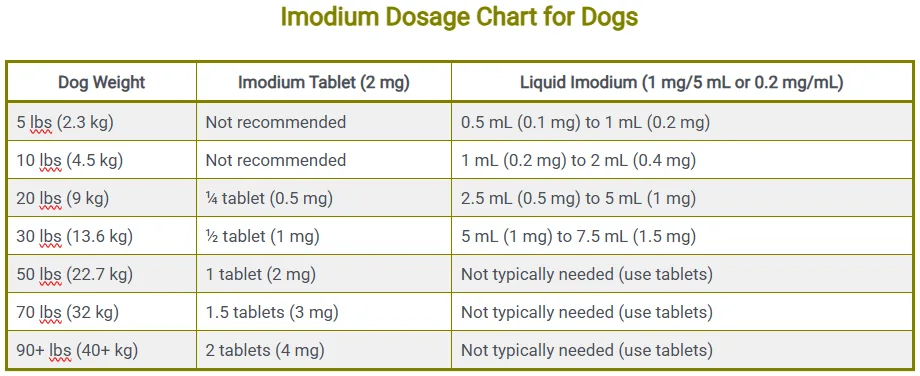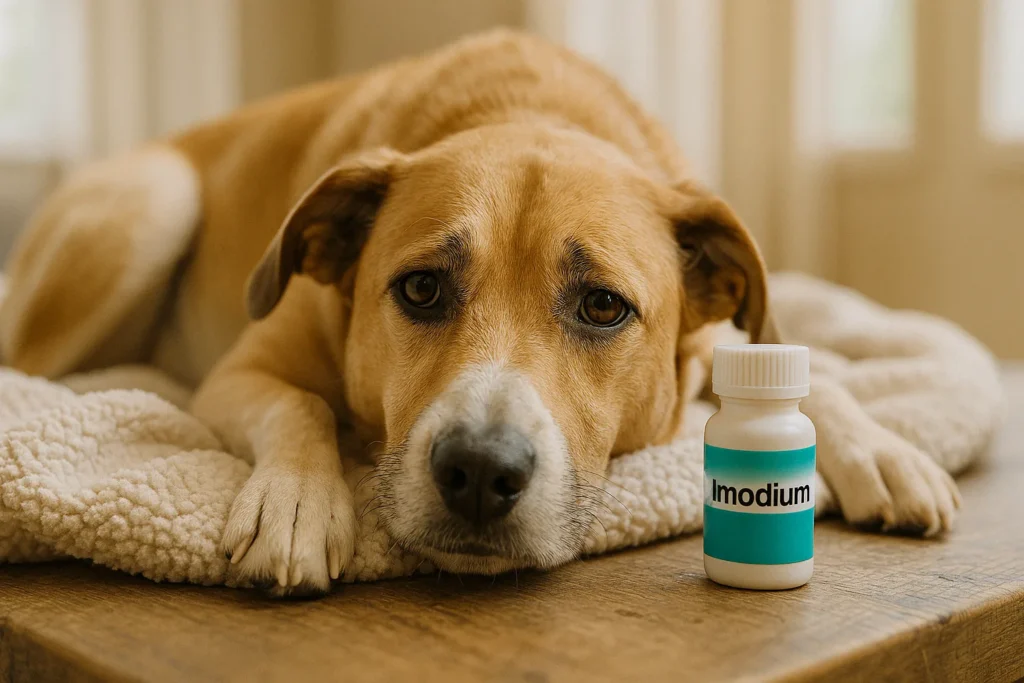The recommended Imodium (loperamide) dosage for dogs is 0.1–0.2 mg per pound of body weight, given every 8–12 hours. However, Imodium can be dangerous for certain breeds and dogs with specific health conditions, so always consult your vet before administering it.
Dealing with doggy diarrhea can be distressing for both you and your furry friend. In a pinch, you might wonder if Imodium, a common over-the-counter human anti-diarrheal medication, can offer relief.
While Imodium (loperamide) can sometimes be used in dogs, it’s crucial to understand the correct Imodium dosage for dogs and the potential risks involved.
This DIY guide will walk you through the essential information, emphasizing safety and when professional veterinary help is absolutely necessary.
Key Takeaways
- What is Imodium?: An over-the-counter antidiarrheal medication containing loperamide.
- Safe Dosage: Typically 0.1–0.2 mg/kg of body weight, administered 2–3 times a day.
- Precautions: Avoid use in herding breeds, puppies, pregnant dogs, or those with underlying health issues.
- Consult a Vet: Always seek professional guidance before administering Imodium to your dog.
Can You Give Imodium to Your Dog?
Yes, you can give Imodium to your dog under specific conditions. The recommended dosage depends on your dog’s weight and health status, but it should always be administered after consulting with a veterinarian. Imodium helps manage diarrhea by slowing intestinal movement, allowing better absorption of water and electrolytes.
However, certain breeds, medical conditions, or genetic mutations may make this medication unsafe for your pet.
As emphasized throughout, never give Imodium without consulting your vet first.
Imodium Dosage For Dogs
- Loperamide dosage is generally 0.1–0.2 mg per kg of your dog’s body weight
- Maximum Daily Dose: No more than 0.8 mg/kg per day.
- Administer 2 to 3 times daily, depending on your vet’s advice
- Not for use more than 2 days in a row without professional supervision
Imodium Dosage Chart for Dogs
| Dog Weight | Imodium Tablet (2 mg) | Liquid Imodium (1 mg/5 mL or 0.2 mg/mL) |
|---|---|---|
| 5 lbs (2.3 kg) | Not recommended | 0.5 mL (0.1 mg) to 1 mL (0.2 mg) |
| 10 lbs (4.5 kg) | Not recommended | 1 mL (0.2 mg) to 2 mL (0.4 mg) |
| 20 lbs (9 kg) | ¼ tablet (0.5 mg) | 2.5 mL (0.5 mg) to 5 mL (1 mg) |
| 30 lbs (13.6 kg) | ½ tablet (1 mg) | 5 mL (1 mg) to 7.5 mL (1.5 mg) |
| 50 lbs (22.7 kg) | 1 tablet (2 mg) | Not typically needed (use tablets) |
| 70 lbs (32 kg) | 1.5 tablets (3 mg) | Not typically needed (use tablets) |
| 90+ lbs (40+ kg) | 2 tablets (4 mg) | Not typically needed (use tablets) |
Imodium A-D Liquid Dosage Chart
| Dog Weight (lbs) | Dosage (mL of liquid Imodium A-D) |
|---|---|
| 10 lbs | 0.5 mL |
| 20 lbs | 1.0 mL |
| 30 lbs | 1.5 mL |
| 40 lbs | 2.0 mL |
| 50 lbs | 2.5 mL |
Note: Use a syringe for accurate dosing. Avoid sugar-free (Xylitol) versions—Xylitol is toxic to dogs.
Potential Side Effects of Imodium in Canines
Even when given at the correct dosage (as determined by your veterinarian), Imodium can have potential side effects in dogs, including:
- Constipation
- Bloating
- Sedation or Fatigue
- Dry Mouth
- Abdominal Discomfort
- Drooling
Signs of Overdose: Watch out for symptoms such as heavy sedation, constipation, bloating, or abdominal discomfort. If you suspect an overdose, contact your veterinarian immediately
When NOT to Give Your Dog Imodium
There are several situations where administering loperamide to your canine can be dangerous and is strongly discouraged:
Certain breeds (Collies, Shelties, Australian Shepherds, White Swiss Shepherds, Long-Haired Whippets, McNabs, Old English Sheepdogs, and English Shepherds) are prone to this genetic mutation, which can cause severe neurological toxicity with Imodium.
Puppies Under Six Weeks Old:
Their systems are too delicate to handle this medication.
Dogs with Known Hypersensitivity:
If your dog has had an adverse reaction to Imodium in the past.
Diarrhea Caused by Infection or Toxins:
Imodium can mask the underlying problem and potentially worsen the condition by slowing down the elimination of the infectious agent or toxin.
Bloody or Black, Tarry Stool:
These are signs of potentially serious internal issues requiring immediate veterinary attention.
Lethargy, Fever, Vomiting, or Loss of Appetite:
These accompanying symptoms suggest a more severe underlying condition that needs proper diagnosis and treatment.
Underlying Medical Conditions:
Dogs with liver disease, respiratory issues, endocrine disorders, or head injuries should generally avoid Imodium.
Safe Alternatives and Home Remedies for Mild Dog Diarrhea
For mild cases of diarrhea, your veterinarian might suggest some safer home remedies or alternatives, such as:
- Withholding food for 12-24 hours (always ensure your dog has access to fresh water).
- Feeding a diet of plain boiled chicken or low-fat ground beef mixed with plain white rice. Plain canned pumpkin (not pumpkin pie filling) can also be beneficial due to its fiber content.
- These can help restore the balance of good bacteria in the gut. Choose a probiotic specifically formulated for dogs.
- These over-the-counter medications are specifically formulated for pets and can help absorb toxins and soothe the digestive tract.
- For dogs with food sensitivities, a bland, limited-ingredient diet can help.
FAQs
Can I give Imodium to my puppy?
No, it’s not safe for puppies unless your vet specifically recommends it. Their systems are too delicate.
What if my dog ate Imodium accidentally?
Call your vet or animal poison control immediately—especially if your dog is a sensitive breed.
Can I give Imodium with other meds?
It depends. Some medications can interact dangerously. Always ask your vet before combining treatments.
How long can I safely use Imodium?
No more than 1–2 days without veterinary supervision. Prolonged use can mask serious issues.
What are the best natural alternatives?
Pumpkin puree, bone broth, and a bland diet of rice and chicken are safe and effective for most mild cases.











![Can Dogs Eat Blood? 7 Side Effects [Expert Opinion]](https://petskor.com/wp-content/uploads/2022/04/Webp.net-resizeimage-12.jpg)
